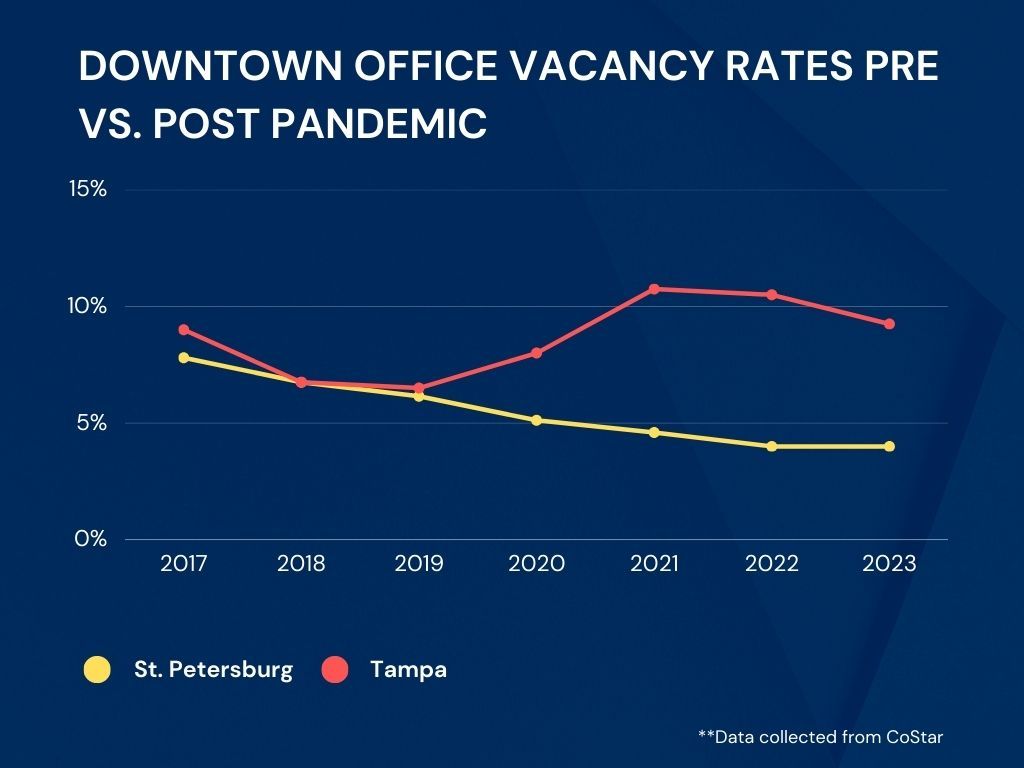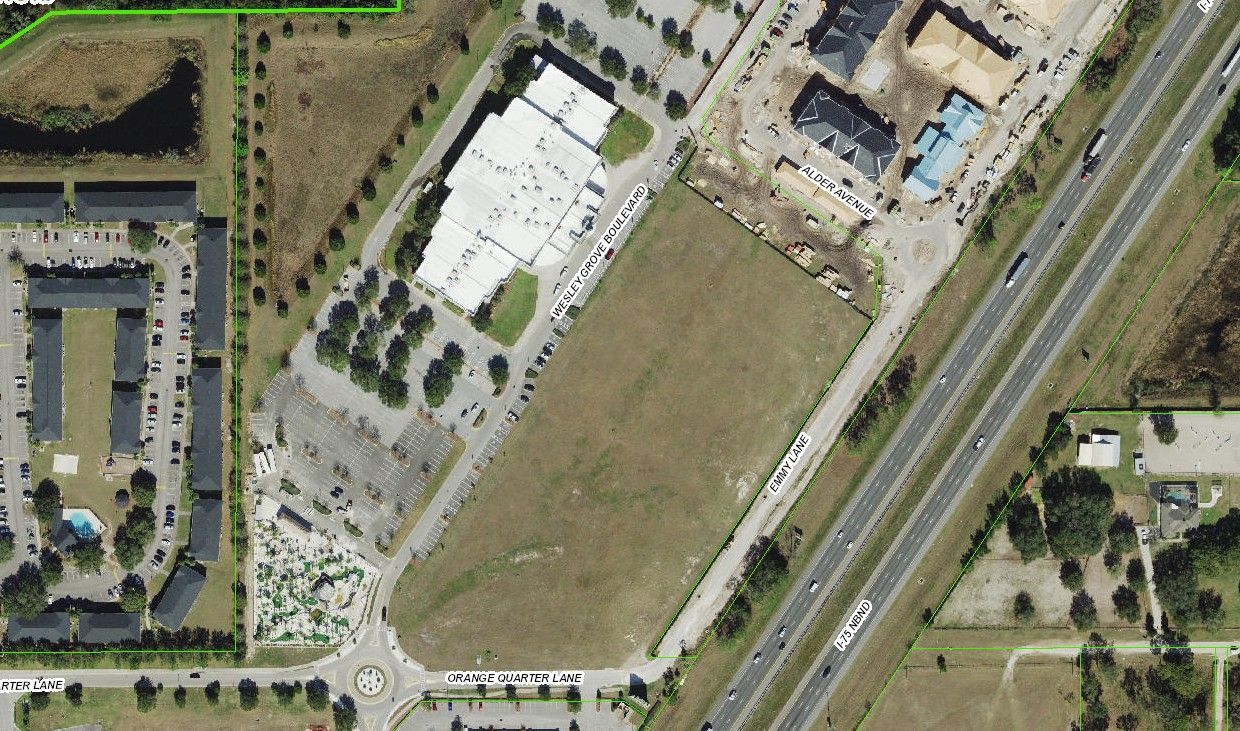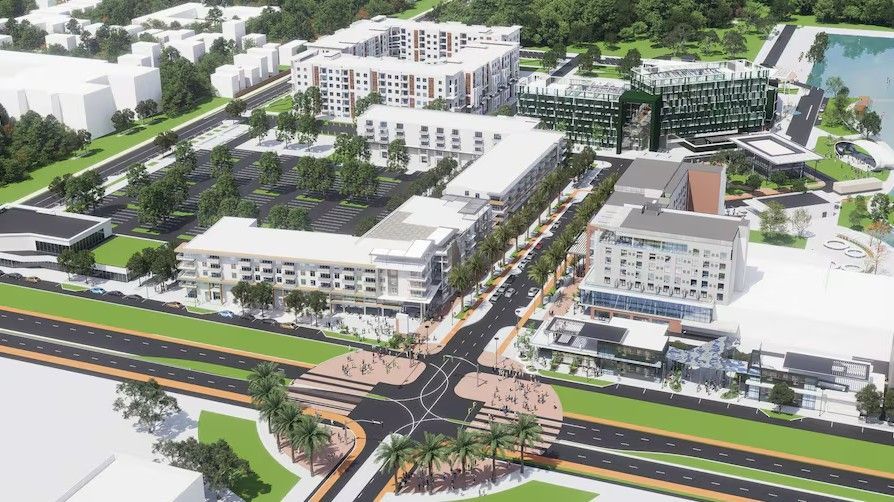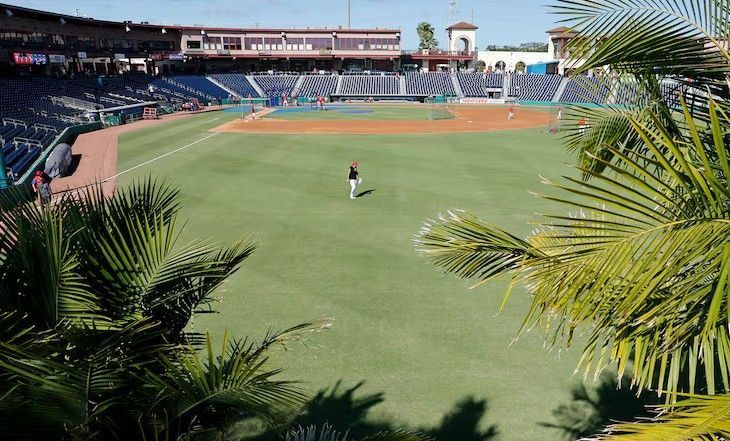Downtown St. Pete & Tampa Office and Multi-Family Vacancy Rates Pre VS. Post Pandemic
The height of the COVID-19 pandemic left many experts predicting that big cities would enter downward spirals as remote workers sought more space, at cheaper costs. With the rise of remote & hybrid work being allowed by employers to “flatten the curve” – cities that once thrived off the backs of office workers, suddenly felt economic repercussions. Historically, big cities relied on workers at shops, restaurants, and bars before, during and after their 9-5 shifts.
In the Tampa Bay region, multi-family and office space are both still in high demand. Commercial real estate inventory specifically is well below market demand. With the number of businesses and people moving to the region not showing a sign of slowing down, the demand for space continues to increase. Foot traffic and rent data are showing that the pandemic has shifted the urban center of gravity, with workers moving from sterile office districts to neighborhoods with restaurants, bars, gyms, and local shops. Cities are beginning to adjust to the idea that they are not just a place to work – but a place for those who reside in them to connect with others in a live, work, and entertainment environment.

The downtown areas of Tampa and St. Petersburg are rapidly adjusting to meet the demands of those wanting a live-work-play walkable district. Downtown office vacancy rates recorded by CoStar as of May 2023, show a trend in declining vacancies. Restaurants, bars, shops, and businesses are thriving in Tampa and St. Petersburg downtowns since they are revamping to meet the new needs and demands of those who work and live in downtown. According to Strategic Property Partners, the developers behind Water Street –the Sparkman Wharf office spaces are now 100% leased with no vacancies, and the Thousand & One office tower is now over 80% leased. Downtown Tampa is defying the trend of tenant downsizing and has seen several firms and businesses relocating to the area.
Downtown St. Petersburg is also showing a similar trend, maintaining some of the lowest office vacancy rates in the region sitting at 3.9% as of the second quarter of 2023. There is a lack of new construction in downtown St. Pete, which gives landlords the ability to increase asking rates for leased space. The proposed Gas Plant District in St. Pete, which will be redeveloped by Hine’s proposes 1.4 million square feet of new office space, over several phases and years. This will lead to an increase in office vacancy in future forecast trends, but otherwise both the Tampa and St. Petersburg downtown office markets show promising rates of low vacancies for years to come.

Despite the Tampa area having the highest jump in rent costs in the nation since the start of the pandemic, and an increase in new inventory from recent completions, Downtown Tampa’s vacancy rates for multifamily units have dropped 2.2% in the last year. Downtown Tampa remains a hot spot for renters, thanks to the expansion of office-using renters in the urban core. Those who live downtown can easily walk to work, stores, restaurants, and bars making the area a vibrant and in-demand spot. Downtown Tampa at the end of the second quarter has a 9.1% vacancy rate for multifamily units.
St. Petersburg’s vacancy rate has increased over 5% for the first time since 2020 as of the second quarter of 2023, at an 8.6% vacancy rate. Renter demand has been at the highest this year that it has been since 2021, but an imbalance of units delivered has increased vacancies, with a further increase expected before the end of the year. Demand in downtown has been softer due to asking rents being over the market average by $500/month, with 4- & 5-star communities being prominent in the downtown St. Petersburg area.
As we can see, Tampa and St. Petersburg have proven to have strong and desirable urban cores, with demand for more office and multifamily space. The development of the Gas Plant District in St. Pete, Gas Worx District (Tampa/Ybor) and the second phase of Water Street (Tampa) development will only attract more consumers to the markets.
In Downtown Tampa, the Tampa Bay Business Journals reference the area as having an office-anchored environment where more employers are embracing the hybrid work environment. In 2022, 43% of downtown office workers had a hybrid schedule, splitting time between the office and remote locations. This is comparable to only 34% in 2022.
Even with the construction boom of multi-family development in downtown Tampa, the office environment still anchors Tampa’s downtown core. CBRE Group Inc. says that Tampa’s central business district has just over 14% of total office vacancy space in the first quarter of 2023. The central business district has 6.9 million square feet of office space. This means almost 1 million square feet of office space is available in the central business district. As shown on the graph at the beginning of this article, CoStar tracks downtown vacancy rate at just under 10%. We note CoStar’s downtown area varies from the CBD area quoted by CBRE. Data from CoStar also shows many are leaving older office spaces to move into newer ones that provide newer spaces and better amenities.
Thousand & One on Water Street is currently 80% leased. Law firms and big names are leasing spaces starting at 20,000 SF or more. The law firm Bradley has expanded from Birmingham, Alabama to the 20-story office tower committing to 37,000 SF on the 10th and 11th floors. ReliaQuest, a billion-dollar cybersecurity firm has settled headquarters into Thousand & One as well, leasing the top seven floors spanning 142,000 SF making them the anchor tenants of the new office building – Tampa’s newest in over a decade. Older buildings such as the Wells Fargo Center (100 Ashley Drive) and the 100 North Tampa building (100 N Tampa St), have seen a loss of tenants with the Wells Fargo Center losing 62,360 SF of occupancy and 100 North Tampa losing 30,186 SF of occupancy in the last 12 months.
The pandemic changed corporate real estate forever – but newer office spaces in Tampa are showing there is still a demand for space when there are amenities to cater to workers. 180,000 SF of office space in Sparkman Wharf is 100% leased. Thousand & One will be 85% leased out if negotiations with three companies for space in the tower come to fruition. With companies adjusting to hybrid workplaces versus fully remote or fully in office, companies can afford to shed office space and pay higher rates for less space in higher quality spaces.
According to the Tampa Bay Business Journals, 75% of office tenants relocated to Water Street’s first phase of office space from within the Tampa Bay Region. The CBD’s office towers are all nearing 30 years in age and need revamping if they want to attract or retain leases.
The pandemic has changed the way many work, with different industries having the ability to adjust to either completely remote work, or hybrid work. Today, there is a much tighter labor market, so employers are very careful when adjusting the requirements for days in the office. Tampa and Saint Petersburg downtown areas have seemingly recovered well from the pandemic and vacancy rates are expected to remain consistent through the remainder of the year with small increases as more office and multi-family spaces become available to the market. Companies that do require employees to be in the office at various times are making their spaces more appealing to the workers with more collaborative space and amenities taking inspiration from the hospitality industry.
Sources: Data Collected from CoStar | Ashley Gurbal Kritzer - TBBJ | Tampa Bay Business Journals
Thank you for your interest. If you are in need of Appraisal/Valuation services in St. Petersburg or Tampa, contact:
Mike Cliggitt, MAI, MRICS, CCIM
813.405.1705 - Direct Line
SHARE CONTENT





